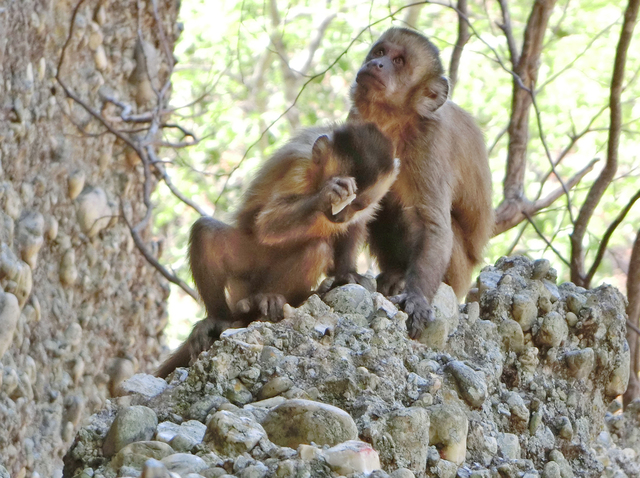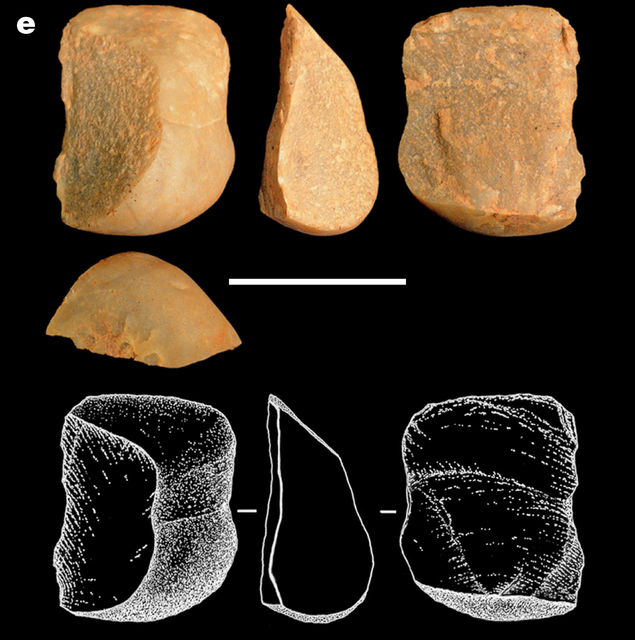It does not pay to underestimate a monkey with a rock. Scientists studying the stone-smashing habits of bearded capuchin monkeys in Brazil have found that the primates inadvertently produce stone flakes that look very similar to the flakes used as
It does not pay to underestimate a monkey with a rock. Scientists studying the stone-smashing habits of bearded capuchin monkeys in Brazil have found that the primates inadvertently produce stone flakes that look very similar to the flakes used as cutting tools by early humans.
The findings, published in the journal Nature, could throw a snarl in the links that paleoanthropologists make between early Stone Age artifacts and the emergence of primitive human technology.
“It does raise interesting questions about the level of cognitive complexity — how intelligent a hominin has to be in order to produce what we thought was a sophisticated technology,” said lead author Tomos Proffitt, a paleoanthropologist at Oxford University.
When anthropologists explore early human settlements, they typically search for signs of tool use, whether by looking at the cuts on butchered animal bones or finding the tools themselves. Some of the earliest tools were simply stone flakes — sharp-edged fragments that were knocked off of a rock by hitting it with another rock at a tangential angle. Such shaped stones are seen in the archaeological record in Africa well over 3 million years ago. These stone flakes were later refined into Stone Age tools known as hand-axes — typically teardrop-shaped, with a rounded end for gripping and a sharp end for cutting.
The fragments have a number of telltale characteristics, the study authors pointed out. They usually feature what’s known as “conchoidal flaking,” a type of fracture pattern that doesn’t really occur naturally; they also feature sharp cutting edges. At human sites, multiple flakes are usually found from the same original rock, because a human toolmaker would often knock several off. These and a few other characteristics, taken together, are not found in nature, and so are thought to be caused intentionally by humans.
Humans are not the only species to use tools — for example, crows, elephants and a number of primates have been documented using tools in the wild. Chimpanzees are known to use stones as hammers to crack nuts. While their stone-smashing might occasionally result in stone shards, those do not quite look like the flakes that ancient hominins created.
That is, until an Oxford-led team of researchers studied the rock-smashing habits of wild bearded capuchin monkeys (known formally as Sapajus libidinosus). The monkeys in the Serra da Capivara National Park use stone tools for a wider variety of activities than any nonhuman primate, the researchers said — for pounding food, digging, and in sexual displays. But capuchins also seem to do something that no other wild primates do — smash the stones in order to damage them.
The scientists watched as capuchins took quartzite stones and used them as hammers to smash quartzite cobbles embedded in the ground, and then apparently licking or sniffing crushed dust from the damaged rock. In the process, they ended up breaking flakes off of the hammer stones, which the scientists then gathered and sent to Proffitt.
“As soon as I saw this material, it was pretty clear that it was something quite special that needed to be examined,” he said.
The flakes featured sharp edges and conchoidal fracturing. And multiple flakes seem to have been pounded off of the same rock core — just as an early human might have done.
Even though flakes that were created by the capuchins looked remarkably like those created by ancient humans, the capuchins don’t seem to have any interest in using the sharp edges, Proffitt added. They mostly seem interested in licking up the rock dust.




